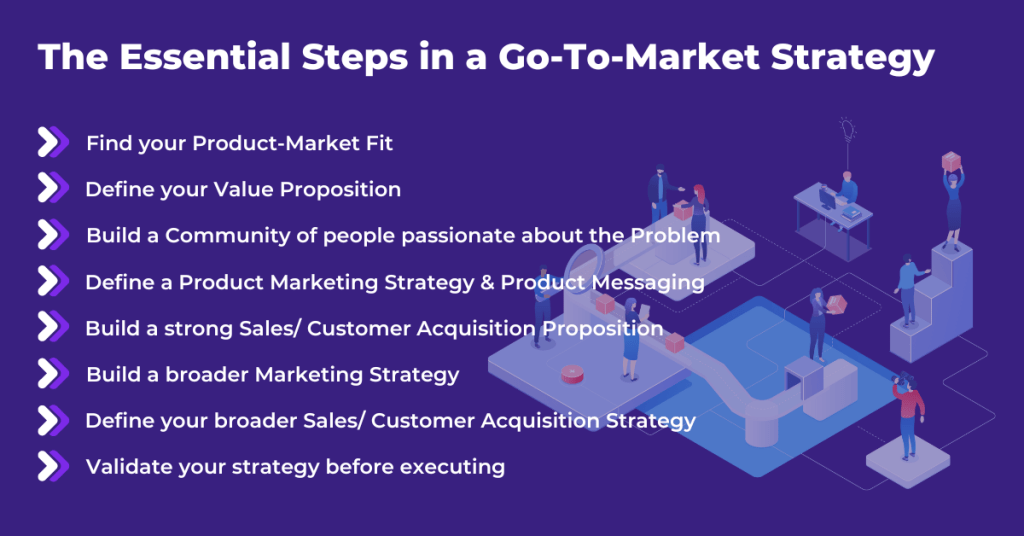As a founder building your first go-to-market strategy, you may find the process overwhelming. Its success depends on many factors, from understanding the context to being able to build a community passionate about the problem you’re solving, where you can test and optimize.
The good news? With passion, diligence in following the key steps, and attention to the areas that have the most impact, you can run a successful go-to-market. The bad news? You may not nail it from the first campaign. Which is why learning to focus on the areas with the highest potential impact is so crucial.
Below, we are joined by ecosystem builders and startup growth advisors in breaking down the process of building a go-to-market strategy in key steps, but not before they each share their “secret sauce” – those less known aspects of a GTM strategy that are paramount for success.
The Recursive: What is the secret sauce to building a top-notch go-to-market strategy?

David Achim, Executive Director at Make IT in Oradea:
“Stop thinking in terms of “let’s prepare a BIG release campaign” and spend tons of money on a first campaign that is VERY likely to fail. Think lean. Start small, learn, adapt, iterate, and relaunch.”
“First, please pay attention to the context! Gary Vee has an amazing quote about this: content is king, but context is queen… and she runs the household. In my 10 years of experience doing marketing campaigns for different clients, I found this to be the number 1 reason why a campaign works EXTREMELY well or it’s just “meh”. Especially if we are talking about virality. The number 1 reason why something becomes viral is because the context was right! In order to “get the context right”, you need empathy and data.
Second, I have bad news for you: there are veeeeeery few chances you will nail it from the first campaign. So, please stop thinking in terms of “let’s prepare a BIG release campaign” and spend tons of money on a first campaign that is VERY likely to fail. Think lean. Start small, learn, adapt, iterate, and relaunch. You will save yourself and your investors a lot of stress, trouble, and money.
Last but not least: MEASURE! If you want to learn what went wrong or what went well, you need to make sure you measure and track your campaigns top-bottom, A-Z, first click on the Ad to the last click towards buying/using your product and afterward also… And make sure you don’t get yourself fooled by ghost KPIs. Be true to yourself, your investors, and your partners.”
Valentin Țoc, Startup Programs Manager at Rubik Hub:
“Building a community along with your startup can be a powerful way to validate, and then drive adoption, and growth.”
“It is never too early or too much to talk to people, potential customers, users, and partners. By doing this, you can get a better understanding of what they need and how your product or service can help them.
You have to care about what you’re doing and who you are doing it for. This means being passionate about your startup and genuinely wanting to help people. When you care about what you’re doing, it shows in your work. It is essential to consider your “why”.
Building a community along with your startup can be a powerful way to validate, and then drive adoption and growth. Your startup becomes more valuable as more people use it.
Have a “give before you get” mindset. Helping others and giving back can be a valuable way to build a network of like-minded people and attract potential partners or customers. This also means being responsive to your client’s needs and offering support and resources to help them succeed.”
Marius Istrate, Venture Partner at 3VC, Growth Adviser, UiPath Alumni:
“Go-To-Market is about your customers’ needs, not about your product.”
“Make sure you have product-market fit – that you are solving a real customer pain – before you start to invest in scaling Sales and Marketing. Any top-notch strategy needs to start from a real problem you are successfully solving for customers/users.”
Janet Todorova, Head of Expansion at Founder Institute:
“Hand hold your first 10 customers (for B2B) and your first 100 customers (for B2C) and that way you can build your core community of people who are passionate about your product and your vision.”
“I mostly work with pre-revenue startups, so my recommendation is for startups at that stage. Focus on community building and testing.
In the beginning, go-to-market means to solve the problem that your company is solving for just one customer – it’s going to be slow, manual, and high touch but your goal at this point is to learn a ton about your customer and their pain. Hand hold your first 10 customers (for B2B) and your first 100 customers (for B2C) and that way you can build your core community of people who are passionate about your product and your vision. If you have a community you can grow easier. If you crack this, find out what to do next in books and seek advice from mentors in your network.”
The Recursive: What are the essential components of a go-to-market strategy?

David Achim, Executive Director at Make IT in Oradea
“When you plan your go-to-market strategy there are a dozen strategies you can adopt. What stays at the core of a great go-to-market strategy is ”The Value Proposition”. If you get this right, everything else will fall into place. Strategyzer’s Value Proposition Map it’s a great place to start designing your Value Proposition.
The second essential component of a great go-to-market strategy is a novel, channel-fit, frictionless customer acquisition campaign. When I say “novel”, I also think about “unique”, but sometimes unique is not relevant to your audience. I also refer to the content you use in your campaign. Make sure it’s something people don’t see everywhere!
Channel-fit is pretty straightforward: find the best channel to communicate the content. Best channel = your audience is there and competition is low. It doesn’t have to be TikTok. It can be e-mail or postcards!
Last but not least: frictionless. This is crucial. If the customer journey towards buying/using your product looks like a SEAL training field, the best value proposition will not work, the most incredible content will not matter and the channel will be irrelevant. You will just throw money through the window.”
Valentin Țoc, Startup Programs Manager at Rubik Hub:
“A go-to-market (GTM) strategy is a plan that outlines how an early-stage startup will introduce its product or service to the market and reach potential customers. It is essential for any startup that wants to achieve predictable growth and avoid costly risks. Several components make up a great GTM strategy.
The value proposition is an essential component of the strategy. It is a statement that communicates the benefits and value of your startup to the customer. It should address the problem your startup is solving for the customer and why it is the best solution. The Rubik Hub tip: make it easy to understand and self-explaining.
But before this, you need to validate if it is a nice-to-have problem or a problem worth solving. Your startup should solve a problem that is important to your target market.
Another crucial component is talking to people. You need to get out of the building: get out of your garage, laboratory or office, and connect with the real people who will become your users and clients.
Before this, you need to discover who you need to talk to and find out the Total Addressable Market (TAM) to measure the size and potential of the market you are entering. The Rubik Hub tip: Understanding the TAM helps to define the scope of the market opportunity and guide decision-making about resources, budget, and time.
After this, it is time to create a customer persona, a detailed profile of the ideal customer for your startup. It should include information about the customer’s pain points, needs, and willingness to pay for a solution. The Rubik Hub tip: Find the early adopters and focus on understanding them.
It’s important to consider whether your startup is geared towards business customers (B2B) or consumers (B2C). This can impact your GTM strategy, as the sales and marketing approaches may differ between the two. The Rubik Hub tip: B2B2C helps you scale faster. Develop how you can leverage the network effect to achieve your goals.
Validate the components of the strategy before executing it. This can be done through pre-selling, where you test the market demand for your product or service before fully launching it. The Rubik Hub tip: interview, observe their behaviour, talk, get feedback, listen, read about their problems, life, reactions, and feelings and gain perspectives. Understanding them helps you validate your assumptions and plans.”
Marius Istrate, Venture Partner at 3VC, Growth Adviser, UiPath Alumnus
- “Product-Market fit should allow you to define a Product Marketing Strategy & Product Messaging.
- Build a strong Sales Proposition, based on the problem you are solving and existing use cases.
- Build a broader Marketing Strategy: definition of the user and buyer personas + building audiences, choosing the right channels, how you reach those audiences, etc.
- Define your broader Sales Strategy: sales channels, pricing, the right cadence in your sales motion, what your sales reps should close, and what the ideal sales rep profile looks like.”
Janet Todorova, Head of Expansion at Founder Institute
“For pre-revenue startups, first, building a community of people sharing your passion about the problem you’re solving and, second, building relationships in your industry and in your startup ecosystem, are among the most critical ingredients for a successful go-to-market strategy.
In the early days of your company, you need to surround yourself with people who love the sloppy first version of your product and people who can open doors for you to do business. The first ones will be happy to become customers and give you feedback to help you clarify your marketing message, communication channels, pricing, etc. The second ones will help you forge critical partnerships or find investors.








